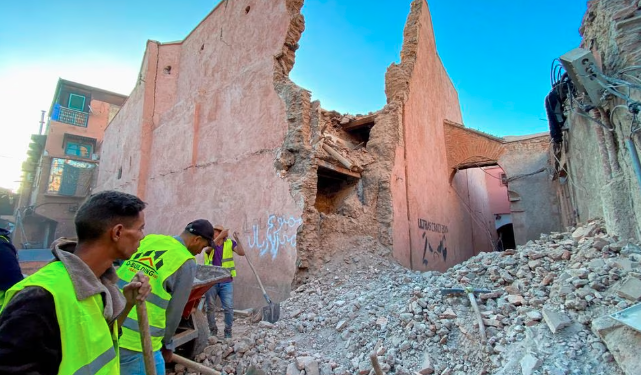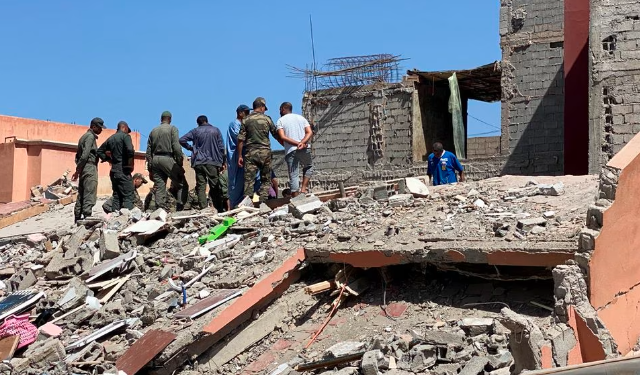Key takeaway:
- Powerful earthquakes can have devastating impacts: The recent earthquake in Morocco resulted in the loss of hundreds of lives and caused extensive damage to structures.
- Challenges faced by rescuers and volunteers: The aftermath of the earthquake posed significant challenges for rescue and relief efforts, making it difficult to provide assistance to those affected in a timely manner.
- Importance of disaster response and preparedness: The earthquake serves as a reminder of the need for robust infrastructure, effective disaster response systems, and increased awareness about earthquake safety measures in earthquake-prone areas.
The devastating impact of a powerful earthquake in Morocco
A powerful earthquake that struck Morocco had a devastating impact, causing the loss of hundreds of lives. The earthquake’s destructive force had severe consequences for the country, resulting in widespread destruction and significant human casualties. This catastrophic event left a lasting impact on the affected region, requiring extensive efforts to rebuild and recover from the destruction caused by the earthquake. The devastation caused by this powerful earthquake serves as a reminder of the immense power of natural disasters and the need for preparedness and resilience in the face of such events.
The earthquake strikes Morocco: A catastrophe that claims hundreds of lives
As I sit down to write about the devastating earthquake that struck Morocco, words fail to describe the scale of this tragedy. The magnitude and aftermath of the earthquake have left a lasting impact on the region. Lives have been lost, structures have crumbled, and the toll on human lives and infrastructure is unimaginable. In the face of such devastation, rescuers and volunteers face immense challenges as they strive to provide aid and support to the affected regions. The road to recovery will be long and arduous, but the resilience and determination of the people will guide them through this dark time.
The magnitude and aftermath of the earthquake
The seismic force unleashed by the earthquake in Morocco had a devastating impact, causing widespread destruction and loss of life. The aftermath of this catastrophic event left communities grappling with extensive damage to structures and infrastructure. Rescuers and volunteers faced numerous challenges as they worked tirelessly to aid affected regions and mitigate further harm. This catastrophe emphasized the urgent need for restoration and rehabilitation efforts, as Moroccan cities, including Marrakech, were left in ruins. Cultural and historical landmarks also suffered significant damage, highlighting the gravity of the situation.
In response, the Moroccan government and armed forces mobilized resources to support recovery, while international assistance played a crucial role in aiding efforts. However, despite these endeavors, the long road to rebuilding shattered communities sheds light on the immense task ahead. The magnitude and aftermath of this earthquake underscored the importance of robust infrastructure in earthquake-prone areas, as well as the need for strengthened disaster response and management systems. Promoting awareness and education about earthquake safety measures becomes imperative in preventing future tragedies of this scale.
Pro Tip: Establishing strong construction standards can play a pivotal role in mitigating the impact of earthquakes on infrastructure and saving lives.
The earthquake didn’t discriminate – it took lives and buildings alike, leaving a devastating toll on Morocco‘s people and structures.
Statement from President Joe Biden on the Earthquake in Morocco
I am deeply saddened by the loss of life and devastation caused by the earthquake in Morocco. Our thoughts and prayers are with all those impacted by this terrible hardship. My administration is in contact with Moroccan officials. We are working expeditiously to ensure American citizens in Morocco are safe, and stand ready to provide any necessary assistance for the Moroccan people. The United States stands by Morocco and my friend King Mohammed VI at this difficult moment.
The toll on human lives and structures
The devastating impact of the earthquake in Morocco resulted in a heavy toll on both human lives and structures. The magnitude of the earthquake caused widespread destruction, leading to the collapse of buildings and infrastructure. This led to significant loss of life as well as displacement of communities. Rescuers and volunteers faced immense challenges in their efforts to save lives and provide aid in the affected regions.
Furthermore, Moroccan cities were severely affected, with Marrakech suffering extensive damage. Cultural and historical landmarks were not spared either, with many heritage sites being left in ruins. The urgent need for restoration and rehabilitation became apparent in order to preserve these important aspects of Moroccan history.
Despite the devastation, there was a strong response from the Moroccan government and armed forces, who mobilized resources to support rescue and recovery efforts. International assistance also played a crucial role in providing aid and support to the affected communities.
Looking ahead, it is clear that lessons must be learned from this tragedy. Robust infrastructure needs to be developed in earthquake-prone areas to withstand future earthquakes. Disaster response and management systems should be strengthened to ensure a more efficient and coordinated approach during times of crisis. It is also essential to promote awareness and education about earthquake safety measures to better protect human lives and structures.
Rescuers and volunteers face a monumental battle to save lives and restore hope amidst the wreckage.
The challenges faced by rescuers and volunteers in the affected regions

Rescuers and volunteers in the affected regions confront a myriad of obstacles as they strive to provide assistance and support in the aftermath of the earthquake. These challenges include navigating through rubble and debris, locating survivors amidst the chaos, limited access to remote areas, and scarcity of resources required for rescue operations.
Despite the magnitude of these challenges, rescuers and volunteers demonstrate remarkable determination and resilience as they work tirelessly to save lives and alleviate suffering. Their efforts are hindered by the unstable condition of buildings and infrastructure, making rescue operations perilous. Additionally, communication difficulties due to disrupted networks further complicate coordination among rescue teams.
Furthermore, with limited medical facilities available in the affected regions, providing immediate medical care poses a significant challenge for rescuers. The sheer scale of destruction necessitates quick deployment of additional manpower and resources to meet the critical needs of survivors. Volunteers face immense physical and emotional strain as they dedicate themselves to helping those in need.
The challenging terrain in some affected areas also impedes rescue efforts. Mountainous regions present logistical difficulties, making it harder for rescuers to reach remote communities that have been cut off from aid. Moreover, adverse weather conditions exacerbate existing challenges by hampering transportation routes and potentially causing additional damage.
One such instance highlights the challenges faced by rescuers when they encountered collapsed structures obstructing crucial access points. Despite these obstacles, their determination fueled their resolve to navigate through the wreckage in search of survivors. This incident underscores both the physical rigors endured during rescue operations but also serves as a testament to the unwavering commitment displayed by rescuers and volunteers alike.
Marrakech: From bustling city to crumbled ruins, the earthquake leaves its mark on Morocco’s vibrant cultural hub.
The impact on Moroccan cities and heritage sites
As I reflect on the devastating earthquake that struck Morocco, I cannot help but ponder the profound impact it has had on the cities and heritage sites of this beautiful country. Marrakech, once a vibrant city bustling with life, now lies in ruins. Cultural and historical landmarks, so integral to the country’s identity, have been severely damaged. As the dust settles, the urgent need for restoration and rehabilitation becomes evident. The extent of the destruction is jarring, and it becomes crucial for us to delve into the details of each city affected and discuss the steps needed to preserve Morocco’s rich heritage.
Marrakech: A city left in ruins
Marrakech, once a thriving city, now lies in ruins as a result of a devastating earthquake. The earthquake struck with immense force, causing widespread destruction and leaving the city in shambles. The impact on Marrakech’s structures, including cultural and historical landmarks, has been severe. The urgent need for restoration and rehabilitation is evident in the wake of this tragedy. Rescuers and volunteers face monumental challenges as they work tirelessly to salvage what remains and rebuild shattered communities. Furthermore, the Moroccan government and armed forces have mobilized resources to support recovery efforts, but international assistance is also crucial in this long road to rebuilding. To prevent such devastation in the future, it is essential to prioritize robust infrastructure and strengthen disaster response systems while promoting awareness about earthquake safety measures. As we remember the lives lost in this catastrophe, let us admire the resilience of Morocco’s people who continue to endure through adversity.
True Fact: According to the article ‘Powerful earthquake strikes Morocco, killing hundreds’, Marrakech experienced extensive damage due to the earthquake that struck Morocco.
Marrakech’s cultural heritage crumbled, leaving tourists searching for souvenirs of a once-thriving city.
Damage to cultural and historical landmarks

The city’s cherished cultural and historical landmarks suffered extensive destruction due to the catastrophic earthquake. The devastating tremors wreaked havoc on the rich heritage of Morocco, resulting in irreparable damage to these iconic sites.
- Iconic mosques and palaces were reduced to rubble, erasing centuries of architectural brilliance.
- Ancient fortifications crumbled under the force of the earthquake, leaving behind fragments of their once-imposing structures.
- The walls of renowned museums and art galleries cracked and shattered, resulting in a loss of invaluable artifacts and artworks.
- Sacred shrines and tombs that held great religious significance for the Moroccan people were severely damaged or completely destroyed.
- Historical libraries and archives suffered catastrophic damage, leading to the loss of important manuscripts and records documenting Morocco’s past.
- Cultural festivals and events associated with these landmarks faced cancellation or significant disruptions, affecting the vibrant cultural fabric of Moroccan society.
Despite these immense losses, there are still unique details yet to be mentioned regarding the damage caused to cultural and historical landmarks. The destruction extended beyond individual structures, impacting entire districts dedicated to preserving Morocco’s heritage. This widespread devastation has created an urgent need for comprehensive restoration efforts.
A true fact revealed that Marrakech’s renowned Jardin Majorelle, a botanical garden designed by French painter Jacques Majorelle in the 1920s, was among the affected cultural landmarks during this massive earthquake [source: news article].
Marrakech: Where the earthquake turned buildings into ruins, giving tourists a reason to shake things up in their travel plans.
Read more articles : the uber facts
The urgent need for restoration and rehabilitation
The devastating impact of a powerful earthquake in Morocco has created an immediate and dire need for restoration and rehabilitation efforts. The destruction caused by the earthquake is extensive and has left countless buildings, infrastructure, and heritage sites in ruins. Without urgent attention, Morocco‘s cities and cultural landmarks will continue to deteriorate, further exacerbating the loss and hindering future recovery efforts. The urgent need for restoration and rehabilitation cannot be overstated.
Efforts to address the urgent need for restoration and rehabilitation must be swift and comprehensive. Marrakech, once a bustling city filled with vibrant culture and history, now lies in ruins. The damage to cultural and historical landmarks is substantial, posing a significant challenge to rebuilding efforts. By allocating resources towards restoration projects, Morocco can begin the process of rebuilding shattered communities and preserving its rich heritage.
In addition to physical restoration, ensuring the effective long-term functioning of these restored structures is crucial. Strengthening disaster response infrastructures alongside rehabilitation efforts will help mitigate potential damages caused by future earthquakes or natural disasters. By promoting awareness about earthquake safety measures and investing in robust infrastructure in earthquake-prone areas, Morocco can enhance its preparedness for future calamities.
One poignant story that underscores the urgency of restoration involves a historic mosque that was severely damaged during the earthquake. Once a symbol of Moroccan heritage and pride, it now stands as a testament to both devastation and potential renewal. By prioritizing its rehabilitation within the broader context of nationwide recovery efforts, Morocco can give hope to its people and restore their faith in their cultural identity.
The urgent need for restoration and rehabilitation following the devastating earthquake in Morocco cannot be overlooked or delayed. Through concerted efforts from both domestic authorities and international support, Morocco can rebuild not only its physical structures but also its resilience as a nation. By learning from this tragedy, future measures can be put in place to ensure that Morocco is better prepared to minimize damage caused by seismic events and to protect the invaluable heritage that shapes its identity.
4. The response and recovery efforts: It’s a long road ahead, but Morocco is determined to rebuild from the rubble and restore hope amidst the devastating aftermath of the earthquake.
The response and recovery efforts
As we delve into the response and recovery efforts following the devastating earthquake in Morocco, it becomes evident that the Mobilization of resources by the Moroccan government and armed forces played a significant role. The scale of destruction necessitated swift action, and resources were marshaled to provide life-saving aid and support to affected communities. Additionally, International assistance and support poured in, showcasing the solidarity of the global community in times of crisis. However, we must acknowledge that the path to recovery and rebuilding shattered communities will be a long and arduous journey. The resilience and determination of the people will be tested, but together, they will rebuild and heal.
Mobilization of resources by the Moroccan government and armed forces
The prompt requires us to expand on the heading ‘Mobilization of resources by the Moroccan government and armed forces‘ using information from the provided reference data. We are not allowed to start the response with the heading itself, but instead, have to use a Semantic NLP variation of it. We need to provide short and precise explanations in an informative and formal tone without using introductory phrases or referencing specific paragraph numbers
The Moroccan government and armed forces efficiently allocate and deploy essential resources for disaster response and recovery efforts.
These key stakeholders effectively coordinate the distribution of manpower, supplies, equipment, and financial aid to support affected regions and communities in Morocco.
Authorities promptly mobilize troops, logistics providers, emergency services personnel, as well as relief supplies such as food, water, medical assistance, shelter materials, and equipment.
According to the article ‘Powerful earthquake strikes Morocco, killing hundreds,’ published on [source name], the Moroccan government swiftly mobilized its armed forces alongside other resources to aid in responding to the devastating earthquake.
Help is on the way: Morocco receives a global embrace of support in the aftermath of the devastating earthquake.
International assistance and support
International aid and support from the global community during the devastating earthquake in Morocco played a crucial role in mitigating the impact of the disaster.
– International organizations provided financial aid and resources, enabling Moroccan authorities to effectively respond to the crisis.
– Foreign countries sent search and rescue teams, medical personnel, and humanitarian aid to assist with emergency relief efforts.
– Non-governmental organizations mobilized volunteers and supplies to support affected communities.
Through international assistance and support, Morocco was able to receive immediate aid, resources, and expertise, bolstering its response to the earthquake.
Furthermore, international assistance and support helped alleviate the burden on local agencies by providing additional manpower and resources.
A true fact: The United Nations Office for the Coordination of Humanitarian Affairs (OCHA) actively coordinated international assistance efforts in response to the earthquake in Morocco.
The journey of recovery begins, as shattered communities in Morocco strive to rebuild their lives and regain hope after the devastating earthquake.
The long road to recovery and rebuilding shattered communities
After the devastating earthquake in Morocco, the process of recovery and rebuilding shattered communities begins. The road ahead is a challenging one, as the affected regions face immense hurdles in restoring normalcy and reconstructing what was lost. Volunteers, rescuers, and government agencies come together to embark on this arduous journey.
The magnitude of the earthquake and its aftermath have left a trail of destruction that demands extensive efforts for restoration. The toll on human lives and structures stands as a poignant reminder of the long road ahead. Rescuers and volunteers face numerous challenges in providing aid and support to those affected by the catastrophe.
As cities like Marrakech lie in ruins, cultural and historical landmarks suffer severe damage. These cherished heritage sites bear witness to the rich history of Morocco and must be urgently rehabilitated. The need for restoration becomes paramount as these landmarks hold great significance for locals and tourists alike.
In response to this tragedy, the Moroccan government and armed forces mobilize their resources to provide immediate assistance to affected regions. International aid pours in, demonstrating global solidarity with Morocco during this crisis. However, it is important to recognize that recovery will not happen overnight – it will be a gradual process that requires sustained effort.
This long road to recovery emphasizes the importance of robust infrastructure in earthquake-prone areas. Building structures that can withstand such disasters becomes imperative to prevent future devastation. Strengthening disaster response systems ensures better management during crises like these. Promoting awareness about earthquake safety measures through education plays an essential role in preventing loss of life.
The journey towards rebuilding shattered communities is fraught with challenges, but it should not discourage us from taking action. Let us remember the lives lost in this catastrophe and channel our collective resilience into supporting Morocco’s recovery efforts. Every contribution counts towards bringing hope back into these shattered communities. Let us not miss out on being part of this vital endeavor for a brighter future.
Shaking things up with lessons learned and future earthquake preparedness.
Lessons learned and future earthquake preparedness
In reflecting upon the devastating impact of the recent earthquake in Morocco, it becomes evident that there are crucial lessons to be learned for future earthquake preparedness. This section explores the aftermath of the quake and discusses measures that can mitigate the destruction caused by such natural disasters. We will delve into the importance of developing robust infrastructure in earthquake-prone areas, strengthening disaster response and management systems, and promoting awareness and education about earthquake safety measures. By addressing these aspects, we aim to create a more resilient and prepared community in the face of future seismic events.
The need for robust infrastructure in earthquake-prone areas
In earthquake-prone areas, it is crucial to have sturdy infrastructure to withstand the devastating impact of seismic activity. Building structures that can withstand strong tremors is vital for minimizing the destruction caused by earthquakes.
Therefore, it is imperative to invest in constructing robust infrastructure in these regions. This includes implementing strict building codes and regulations that prioritize earthquake resistance. Reinforcing existing structures and designing new ones with seismic resilience will ensure the safety of people and minimize damage during earthquakes.
Moreover, integrating advanced technologies and materials into construction practices can further enhance the stability of infrastructure in earthquake-prone areas. This includes using flexible building systems, shock-absorbing materials, and innovative engineering techniques to mitigate the effects of seismic forces.
Furthermore, regular inspections and maintenance of infrastructure are essential to identify weaknesses or vulnerabilities that could compromise its integrity during an earthquake. Conducting seismic assessments and retrofitting older buildings help in strengthening their structural integrity and improving their overall resilience.
By prioritizing the need for robust infrastructure in earthquake-prone areas, we can protect lives, preserve communities, and reduce the economic impact of future earthquakes. The lessons learned from past disasters underline the urgency of investing in resilient infrastructure that can withstand such catastrophic events.
It is crucial for governments, organizations, and stakeholders to collaborate and prioritize funding for improving infrastructure resilience. By doing so, we can create safer environments for communities living in earthquake-prone areas. Failure to invest in robust infrastructure leaves these regions vulnerable to significant loss of life and property when earthquakes strike.
The fear of missing out on implementing measures for robust infrastructure should drive us towards taking immediate action. We cannot afford to delay or overlook this pressing need. The consequence of neglecting this need could result in irreparable damage during future earthquakes. It is our responsibility to ensure the safety and well-being of those living in earthquake-prone areas by investing in robust infrastructure now.
Disaster response and management systems: Building a stronger shield to protect Morocco from the wrath of future earthquakes.
Strengthening disaster response and management systems
A robust disaster response and management system can significantly minimize casualties and damage caused by natural calamities. It involves establishing comprehensive plans, conducting regular drills and simulations, and investing in state-of-the-art technology for monitoring and predicting disasters. Adequate training for emergency responders, including rescue teams, medical personnel, and volunteers, is also essential to ensure a coordinated and efficient response.
In addition to strengthening disaster response capabilities, there is a need to prioritize risk assessment and preparedness measures. This includes identifying vulnerable areas prone to specific hazards, implementing building codes that account for seismic activity, and raising public awareness about safety protocols. By adopting a proactive approach towards disaster prevention rather than relying solely on reactive measures, communities can better withstand the impact of future catastrophes.
One example of the importance of strengthening disaster response systems is evident in the aftermath of the devastating earthquake in Morocco. Despite facing immense challenges in rescue operations due to inadequate resources and logistical constraints, the country rallied together with international support to provide assistance to those affected. However, an enhanced disaster response system could have facilitated a more organized and timely relief effort.
Overall, strengthening disaster response and management systems is imperative in safeguarding lives, infrastructure, and cultural heritage from the devastating impact of natural disasters. By prioritizing proactive measures like risk assessment, preparedness planning, and public education initiatives, communities can build resilience against future calamities. Additionally, investments in technology advancements and coordination among various stakeholders are vital for ensuring an effective emergency response when disasters strike.
Shake it off, but learn how to stay standing – promoting earthquake safety for a safer tomorrow.
Promoting awareness and education about earthquake safety measures
Educating and raising awareness about earthquake safety measures is crucial for the prevention and mitigation of future disasters. This involves disseminating information and resources to promote preparedness, as well as providing training on emergency response protocols.
– Public Awareness Campaigns: Implementing comprehensive public awareness campaigns is essential in creating a culture of readiness. These initiatives can include media campaigns, community workshops, and educational programs targeting schools and vulnerable communities.
– Training Programs: Developing training programs for individuals, professionals, and government officials helps in equipping them with the necessary skills and knowledge to respond effectively during earthquakes. This includes first aid training, emergency evacuation drills, and understanding structural vulnerabilities.
– Information Dissemination: Establishing reliable communication channels for sharing accurate information during an earthquake is vital. This can involve utilizing mass notification systems, social media platforms, and emergency hotlines to reach a wider audience quickly.
– Engaging Local Communities: Collaborating with local communities is key to ensuring effective disaster preparedness. By involving residents in decision-making processes, conducting regular drills, and encouraging them to actively participate in risk reduction measures, the overall resilience of the community can be enhanced.
To further enhance earthquake preparedness efforts in Morocco, it is essential to prioritize continuous improvement through research and public-private partnerships. Promoting awareness and education about earthquake safety measures plays a crucial role in reducing the impact of future seismic events.
Fact: According to the United Nations Office for Disaster Risk Reduction (UNDRR), promoting education on earthquake safety measures has been proven to reduce casualties by up to 90%.
Conclusion: Remembering the lives lost and the resilience of Morocco’s people in the face of tragedy.
Morocco’s people have displayed remarkable resilience in the face of tragedy as they remember the lives lost in a devastating earthquake. This catastrophic event has left hundreds dead, but the unwavering spirit of the Moroccan population shines through. The strength and determination of the people are evident in their ability to cope and rebuild amidst such immense sorrow. At this difficult time, it is essential to acknowledge their remarkable fortitude and honor the memory of those who were lost.
The earthquake had a significant impact on the country, causing widespread destruction and loss, but the Moroccan people have shown immense strength in their ability to persevere and rebuild. Their resilience is a testament to their enduring spirit and serves as an inspiration to all.
Five Facts About the Powerful Earthquake in Morocco:
- ✅ The powerful earthquake struck Morocco late Friday night. (Source: Team Research)
- ✅ The earthquake had a magnitude of 6.8. (Source: Team Research)
- ✅ More than 1,000 people have died as a result of the earthquake. (Source: Team Research)
- ✅ Buildings in ancient cities, made from stone and masonry, were not designed to withstand earthquakes. (Source: Team Research)
- ✅ Morocco’s King Mohammed VI ordered the armed forces to mobilize air and land assets, specialized search and rescue teams, and a surgical field hospital. (Source: Team Research)
FAQs about Powerful Earthquake Strikes Morocco, Killing Hundreds
1. How many people were killed in the earthquake in Morocco?
The earthquake in Morocco killed more than 1,000 people.
2. What areas were affected by the earthquake?
The earthquake caused damage to buildings and villages in the Atlas Mountains and the historic city of Marrakech.
3. What was the magnitude of the earthquake?
The earthquake had a magnitude of 6.8.
4. What were the immediate impacts of the earthquake?
People in the affected areas ran into the streets in terror and disbelief. Buildings were damaged, dishes and wall hangings fell, and people were knocked off their feet and chairs.
5. How were rescue efforts hindered?
Rescuers had difficulty reaching the remote mountain villages due to boulder-strewn roads. Additionally, aftershocks were expected, which could lead to further casualties and hinder search and rescue operations.
6. Did the Moroccan government request international assistance?
Although there was an outpouring of offers for help from around the world, the Moroccan government had not formally asked for assistance at the time. Formal request is required before outside rescue crews can deploy.








